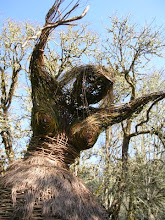in the aftermath of the 1906 San Francisco earthquake and fire.
Many tens of thousands of residents were displaced or homeless after this great disaster.
Card published by The World Wide View Co., Photo (screened print) by Griffith & Griffith
We tend to use terms such as “steady as a rock” and “solid ground” and “down to Earth” to describe stability and immutability. But in fact, our earth is a molten ball of melted rock covered with thin slabs of solid material that float, slip, slide, ooze, fracture, sink, collide, subside and that sometimes melt, flow, and spew. Meanwhile our little planet is whirling around our sun, in a solar system that is traveling through space at incredible speed. It’s enough to give you vertigo, and reading a book such as Simon Winchester’s A Crack in the Edge of the World can make you a lot less sure of your footing.
This book (Harper Collins, 2005) is ostensibly about the 1906 San Francisco earthquake and fire. As he usually does, Winchester uses the San Francisco earthquake as the major “character” in a story that covers a great deal more – plate tectonics, the Gaia theory, seismology, and other aspects of what scientists have come to call “The New Geology” – the revision of geological theories since the mid-1960s.
Winchester undertook a journey across the North American Plate – starting in Iceland at its Eastern perimeter, and traveling across the United States to San Francisco, thence to the northern reaches of Alaska. In order to understand what all this has to do with the San Francisco earthquake, one simply needs to read the book and make the journey vicariously with Winchester, who as always imbues his story with excitement, tension, humor, human interest and anecdote. Nor is he ever afraid to give his personal reaction to a town, a person, a book, or a theory.
Although he is a consummate researcher and made use of many experts in compiling his information, I’d have to quibble with his reference to the death of David Douglas in Hawaii. Winchester relates the old pit and bull story, which was considered to be highly suspect at the time, and has since been disproved by witnesses who came forward long after the fact to testify that Douglas was murdered and tossed into the pit with the bull to simulate an accidental death.
As for the San Andreas fault, Winchester uses a train-car analogy that make a fine clear image of what happens when it generates an earthquake. And as for timing – he brings forth a persuasive argument that another slippage is overdue and likely to occur at any time, but fairly certainly within the next quarter-century or so.
I was disappointed with the inside of the dustjacket – which cleverly unfolds the way that the jacket for The Map That Changed The World does. However, whereas the “Map” jacket had a large depiction of William Smith’s beautiful map of the geology of England and Scotland, the inside of this jacket has only reproductions of some of the disaster scenes from the San Francisco earthquake. Larger renditions of the endpaper maps of the North American Plate and of American earthquakes and volcanoes (and the author’s route), plus a better “close up” of the San Andreas fault itself, would have been far more informative.
Meanwhile, I’m not taking the ground beneath my feet for granted any longer.





No comments:
Post a Comment